Is there anything more frustrating than expecting a cozy, warm ride on a chilly day, only to discover your car heater is not working? We’ve all been there!
While a broken car heater might ruin your winter trips, don’t worry; we’re here to help you determine what’s wrong. This helpful guide looks at some of the most prevalent causes of car heating problems.
We’ll highlight the probable problems impeding your portable car heater’s operation, from mechanical flaws to electrical issues.
Also, while going on the trip, you must not forget about the CarPlay with the best quality subwoofer, which makes your trip fun with your favorite music.
So strap in as we set out to learn and solve why your car’s heating may not be operating correctly.
Let’s rev up our engines and get started!
Table of Contents
How Does a Car Heater Work?
The portable car heater heats the air breathed into the cabin using the engine’s coolant system.
Initially, the thermostat maintains the engine’s proper operating temperature by preventing hot coolant from entering the heater core.
The thermostat opens as the engine heats up, enabling heated coolant to travel into the heater core and heat the air fanned by the fan.
Sometimes there are noxious odors in your car because of the car heater; you can use the best car air fresheners to vanish that odor.
The heater core, a tiny radiator placed behind the dashboard, is critical in this operation. The heated air is channeled into the car’s cabin, providing occupants warmth and comfort during colder weather.
8 Reasons Why Car Heater Not Working Properly
1. Low Coolant Level
 Coolant is an essential component that keeps your automobile engine at an ideal temperature, especially during the hot summer.
Coolant is an essential component that keeps your automobile engine at an ideal temperature, especially during the hot summer.
It also critically supplies warmth through the heater core during the winter.
If your car heater is blowing cold air, the first thing to look for is a low coolant level. Check the clear plastic bottle in your engine area to see whether the coolant needs to be replaced.
Avoid engine overheating by swiftly repairing coolant leaks and ensuring the heater core receives the hot antifreeze to keep you warm while driving.
Remember that a well-maintained coolant system delivers a comfortable and dependable driving experience.
2. Heater Core Issue
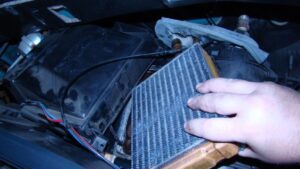 The heater core in your vehicle is similar to a radiator and is in charge of delivering hot air into the passenger compartment.
The heater core in your vehicle is similar to a radiator and is in charge of delivering hot air into the passenger compartment.
It is, however, prone to clogging and leaks, which can result in low coolant levels and engine overheating.
If your car heater isn’t blowing warm air, the heater core may be faulty, as demonstrated by fogged-up windows, a sweet-smelling odor, rapid coolant loss, and engine overheating.
Checking the temperature of the heater core hoses can aid in the detection of obstructions or faulty valves that impede coolant flow. Prompt care of heater core concerns provides a safe and enjoyable driving experience.
3. Heater Control Valve
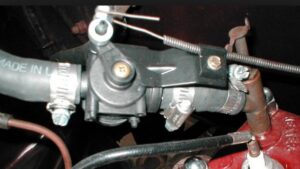 The Heater Control Valve regulates the air temperature within your vehicle’s cabin by managing the coolant flow to the heater core.
The Heater Control Valve regulates the air temperature within your vehicle’s cabin by managing the coolant flow to the heater core.
When malfunctioning or jammed, it can interrupt the heating system’s performance, resulting in chilly or no heat.
This valve diverts or inhibits hot antifreeze from reaching the heater core based on your temperature settings.
This valve must be checked, repaired, or replaced to ensure a comfortable driving experience during the colder months.
4. Defective Thermostat
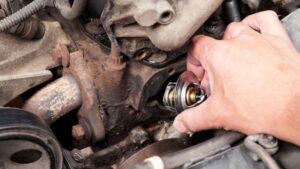 A faulty thermostat is a typical source of car heater issues, leading to engine overheating and poor performance.
A faulty thermostat is a typical source of car heater issues, leading to engine overheating and poor performance.
It might become stuck closed, restricting coolant passage to the radiator, or open, influencing the ideal engine temperature.
Testing and replacing the defective thermostat is a reasonably straightforward and low-cost approach for restoring appropriate heating and preventing future engine damage.
5. The Heater Fan is Not Working
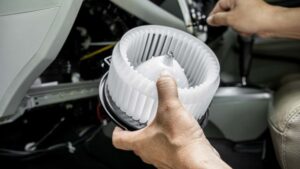 If your heater fan isn’t operating, it might be because of a faulty fan or an electrical problem.
If your heater fan isn’t operating, it might be because of a faulty fan or an electrical problem.
Hot coolant may reach the heater core, but the heat will not be blown into the vehicle’s interior.
The issue might be mechanical or electrical, preventing the fan from adequately spreading heat. To restore appropriate heating in your car’s interior, ensure fast examination and repair.
6. Blower Motor Resistor is Not Working
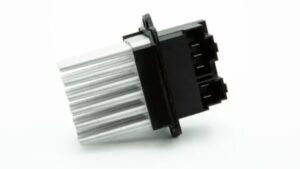 If you’re experiencing problems with your car’s fan speed control or a lack of airflow from the vents when using the heat or air conditioning, the blower motor resistor may be defective.
If you’re experiencing problems with your car’s fan speed control or a lack of airflow from the vents when using the heat or air conditioning, the blower motor resistor may be defective.
The blower fan, which blows air through the temperature control vents, may burn out or develop electrical difficulties over time.
Consequently, your car heater may not blast hot air, and warm air from the heater core may not be evacuated effectively through the vents.
Consider examining and replacing the blower motor to restore correct operation and enjoy a comfortable driving experience.
7. Heat and AC Controls Not Working
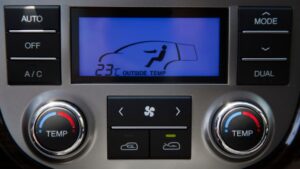 If your heat and air conditioning controls aren’t working properly.
If your heat and air conditioning controls aren’t working properly.
There might be a communication breakdown between the AC/Heater dials, knobs, buttons, or touchscreen orders and the heating system parts.
This might result in inefficient operation. To remedy the problem, look for any faulty connections or components and fix them.
8. Electrical System Issues
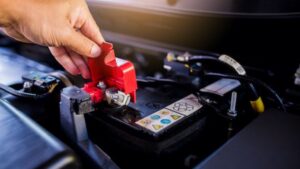 Electrical system difficulties in a car can cause problems in various areas, including the heating and air conditioning systems.
Electrical system difficulties in a car can cause problems in various areas, including the heating and air conditioning systems.
An electrical system issue might cause the heater to fail to blow air or alter the temperature. To guarantee peak performance, proper diagnosis and repair are essential.
Final Thoughts
By identifying common issues such as a faulty heater fan, broken thermostat, or low coolant levels, you’re already on the right track to resolving the problem. Don’t let the chill dampen your driving experience – tackle the problem with confidence and warmth.
Safe travels!


Great troubleshooting guide! Understanding the common reasons a car heater might stop working is beneficial. Do you have any quick fixes for when the heater suddenly stops in cold weather?